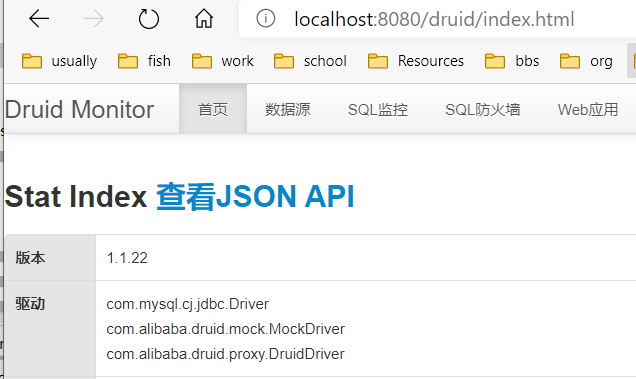springboot-数据库访问之mybatis
选中mysqldirver,数据库驱动器
选中jdbc ,帮我们配置数据源,连接数据库
选中mybatis,持久层
<!-- 这个不是springboot官方出来的,是mybatis为了设备springboot出品的-->
<dependency>
<groupId>org.mybatis.spring.boot</groupId>
<artifactId>mybatis-spring-boot-starter</artifactId>
<version>2.1.3</version>
</dependency>
依赖图:

引入了mybtatis-spring-boot-starter依赖之后,我们可以不引入
我们不是用springboot tomcat内置的数据源,所以加入依赖:
<dependency>
<groupId>com.alibaba</groupId>
<artifactId>druid</artifactId>
<version>1.1.22</version>
</dependency>
前期准备:
1创建数据库mybatis
2创建两个数据表:
CREATE TABLE `employee` ( `id` int(11) NOT NULL AUTO_INCREMENT, `lastName` varchar(255) DEFAULT NULL, `email` varchar(255) DEFAULT NULL, `gender` int(2) DEFAULT NULL, `d_id` int(11) DEFAULT NULL, PRIMARY KEY (`id`) ) ENGINE=InnoDB DEFAULT CHARSET=utf8; CREATE TABLE `department` ( `id` int(11) NOT NULL AUTO_INCREMENT, `departmentName` varchar(255) DEFAULT NULL, PRIMARY KEY (`id`) ) ENGINE=InnoDB AUTO_INCREMENT=8 DEFAULT CHARSET=utf8;
配置相关数据源信息:
spring:
datasource:
# 数据源基本配置
username: root
password: 1997
driver-class-name: com.mysql.cj.jdbc.Driver
url: jdbc:mysql://192.168.1.101:3306/mybatis
type: com.alibaba.druid.pool.DruidDataSource
# 数据源其他配置
initialSize: 5
minIdle: 5
maxActive: 20
maxWait: 60000
timeBetweenEvictionRunsMillis: 60000
minEvictableIdleTimeMillis: 300000
validationQuery: SELECT 1 FROM DUAL
testWhileIdle: true
testOnBorrow: false
testOnReturn: false
poolPreparedStatements: true
# 配置监控统计拦截的filters,去掉后监控界面sql无法统计,'wall'用于防火墙
filters: stat,wall,log4j
maxPoolPreparedStatementPerConnectionSize: 20
useGlobalDataSourceStat: true
connectionProperties: druid.stat.mergeSql=true;druid.stat.slowSqlMillis=500
编写实体类:
Department
package com.quan.springbootmybatis.bean;
public class Department {
private Integer id;
private String departmentName;
public Integer getId() {
return id;
}
public void setId(Integer id) {
this.id = id;
}
public String getDepartmentName() {
return departmentName;
}
public void setDepartmentName(String departmentName) {
this.departmentName = departmentName;
}
}
Employee
package com.quan.springbootmybatis.bean;
public class Employee {
private Integer id;
private String lastName;
private Integer gender;
private String email;
private Integer dId;
public Integer getId() {
return id;
}
public void setId(Integer id) {
this.id = id;
}
public String getLastName() {
return lastName;
}
public void setLastName(String lastName) {
this.lastName = lastName;
}
public Integer getGender() {
return gender;
}
public void setGender(Integer gender) {
this.gender = gender;
}
public String getEmail() {
return email;
}
public void setEmail(String email) {
this.email = email;
}
public Integer getdId() {
return dId;
}
public void setdId(Integer dId) {
this.dId = dId;
}
}
配置一下Druid:
package com.quan.springbootmybatis.config; import com.alibaba.druid.pool.DruidDataSource; import com.alibaba.druid.support.http.StatViewServlet; import com.alibaba.druid.support.http.WebStatFilter; import org.springframework.boot.context.properties.ConfigurationProperties; import org.springframework.boot.web.servlet.FilterRegistrationBean; import org.springframework.boot.web.servlet.ServletRegistrationBean; import org.springframework.context.annotation.Bean; import org.springframework.context.annotation.Configuration; import javax.sql.DataSource; import java.util.Arrays; import java.util.HashMap; import java.util.Map; @Configuration public class DruidConfig { @ConfigurationProperties(prefix = "spring.datasource") @Bean public DataSource druid(){ return new DruidDataSource(); } //配置Druid监控 //配置管理后台Servlet @Bean public ServletRegistrationBean statViewServlet(){ ServletRegistrationBean bean =new ServletRegistrationBean(new StatViewServlet(),"/druid/*"); Map<String,String> initParams = new HashMap<>(); //下面的参数都是 StatViewServlet extends ResourceServlet两个累里面的属性 initParams.put("loginUsername","admin"); initParams.put("loginPassword","admin"); initParams.put("allow","");//默认允许所有 initParams.put("deny","129.204.3.132"); bean.setInitParameters(initParams); return bean; } //配置一个Web监控的Filter @Bean public FilterRegistrationBean webStatFilter(){ FilterRegistrationBean bean = new FilterRegistrationBean(); bean.setFilter(new WebStatFilter()); Map<String,String> initParams = new HashMap<>(); initParams.put("exclusions","*.js,*.css"); bean.setInitParameters(initParams); bean.setUrlPatterns(Arrays.asList("/*")); return bean; } }
可以启动访问一下druid数据源有没有起来:

注解版详解:
编写一个处理sql的接口:
package com.quan.springbootmybatis.mapper; import com.quan.springbootmybatis.bean.Department; import org.apache.ibatis.annotations.*; //指定这个操作数据库的mapper @Mapper public interface DepartmentMapper { @Select("select * from department where id = #{id}") public Department getDepartmentById(Integer id); @Delete("delete from department where id = #{id}") public int deleteDeptById(Integer id); @Insert("insert into department(departmentName) values(#{departmentName})") public int insertDept(Department department); @Update("update department set departmentName = #{departmentName} where id = #{id}") public int updateDept(Department department); }
其中@Mapper指定这个接口mapper接口

我们编写一个Controller进行测试一下:‘
import com.quan.springbootmybatis.mapper.DepartmentMapper; import com.quan.springbootmybatis.mapper.EmployeeMapper; import org.springframework.beans.factory.annotation.Autowired; import org.springframework.web.bind.annotation.GetMapping; import org.springframework.web.bind.annotation.PathVariable; import org.springframework.web.bind.annotation.RestController; //不过返回页面数据直接返回json书 @RestController public class DeptController { @Autowired DepartmentMapper departmentMapper; @GetMapping("/dept/{id}") public Department getDepartment(@PathVariable("id") Integer id){ return departmentMapper.getDepartmentById(id); } //http://localhost:8080/dept/1 @GetMapping("/dept") public Department insertDept(Department department){ departmentMapper.insertDept(department); return department; } //http://localhost:8080/dept?departmentName=CCC
结果:


由于我们的id是自增主键,所以如果默认不设置什么东西,是插入的时候是不会取到主键的值的,所以我们要进行下面的设置:
在mapper接口方法中加入多一个注解@Options
@Options(useGeneratedKeys = true,keyProperty = "id") @Insert("insert into department(departmentName) values(#{departmentName})") public int insertDept(Department department);
/* 在接口里面加入options 是否使用自动生成的主键,用keyproperty指定主键是对应department属性 */
结果就可以得到主键的值了

存在的问题1:如果数据库的列名改为department_name 而department的属性值一样是departmentName不变的时候
是不能匹配到值的,这个时候我们就需要开启自定义的mybatis配置规则
就是需要给容器中加入ConfigurationCustomizer;
所以编写一个配置类取进行配置
@org.springframework.context.annotation.Configuration public class MybatisConfig { @Bean public ConfigurationCustomizer configurationCustomizer(){ // 匿名函数 return new ConfigurationCustomizer() { @Override public void customize(Configuration configuration) { configuration.setMapUnderscoreToCamelCase(true); } }; } }
这个只针对注解 生效的,如果是使用mapper映射文件的就需要使用配置文件取开启
问题2,如果我们@mapper的数量很多的时候,我们需要每个都要加,麻烦!!!!
解决:往配置类,或者主配置类里面注上注解@MapperScan
@MapperScan(value = "com.quan.springbootmybatis.mapper") @SpringBootApplication public class SpringbootmybatisApplication { public static void main(String[] args) { SpringApplication.run(SpringbootmybatisApplication.class, args); } }
去掉之前mapper文件夹里面的所有@mapper

查询结果还是一样的;

这就是使用MapperScan批量烧苗所有的Mapper接口
###############################################################################
配置文件版
创建两个配置文件:
mybatis-config.xml
EmployeeMapper.xml
创建一个接口:
package com.quan.springbootmybatis.mapper; import com.quan.springbootmybatis.bean.Employee; //无论是配置文件还是注解版都需要将接口扫描到我们的容器中 //使用@Mapper或者@MapperScan public interface EmployeeMapper { public Employee getEmpById(Integer id); public void insertEmp(Employee employee); }
注:因为上面的注解版的时候加了@MapperScan注解了,所以这里可以不用加
根据接口编写mapper映射文件:
<?xml version="1.0" encoding="UTF-8"?> <!DOCTYPE mapper PUBLIC "-//mybatis.org//DTD Mapper 3.0//EN" "http://mybatis.org/dtd/mybatis-3-mapper.dtd"> <!--namespace必须和mapper接口的全限定类名绑定--> <mapper namespace="com.quan.springbootmybatis.mapper.EmployeeMapper"> <!-- public Employee getEmpById(Integer id);--> <select id="getEmpById" resultType="com.quan.springbootmybatis.bean.Employee"> SELECT * FROM employee WHERE id = #{id} </select> <!-- public void insertEmp(Employee employee);--> <insert id="insertEmp"> INSERT INTO employee(lastName,email,gender,d_id) VALUES (#{lastName},#{email},#{gender},#{dId}) </insert> </mapper>
注:文件的头部信息可以取官网查看,直接百度进入mybatis
由于实体类和数据库列的名字不一样,一个是dId 一个是d_id
所以需要在mybatis主配置文件里面加入配置规则模式:
<?xml version="1.0" encoding="utf-8"?>
<!DOCTYPE configuration PUBLIC "-//mybatis.org//DTD Config 3.0//EN"
"http://mybatis.org/dtd/mybatis-3-config.dtd">
<configuration><!-- 配置 -->
<settings>
<setting name="mapUnderscoreToCamelCase" value="true"/>
</settings>
</configuration>
开启驼峰模式规则
修改springboot主配置文件:
需要让程序知道映射文件
核心要点就是要在springboot配置文件当中指定mybatis著配置文件和mapper文件的位置:
#mybatis 全局配置文件的位置 mybatis: config-location: classpath:mybatis/mybatis-config.xml # mapper映射文件的位置 mapper-locations: classpath:mybatis/mapper/*.xml
往之前的DeptControler文件加入测试:
@Autowired EmployeeMapper employeeMapper; @GetMapping("/emp/{id}") public Employee getEmp(@PathVariable("id") Integer id){ return employeeMapper.getEmpById(id); }





 浙公网安备 33010602011771号
浙公网安备 33010602011771号